Villages and towns are important places in most fantasy roleplaying games. It’s a place for the adventurers to stock-up on gear before taking off on wilderness or dungeon expeditions, interact with NPC’s, and sometimes the village itself is the main stage of the adventure.
Following up on my tutorials on how to draw basic dungeons and isometric dungeons, I thought it might be useful with a guide on drawing maps of buildings and settlements.
The gear
As always, let’s have a look at the tools I will be using for this tutorial:
- Field Notes dot-graph Notebook
- Micron markers (0.05, 0.1 and 0.3)
- Ice Grey 4 Promarker
- Mechanical pen and eraser
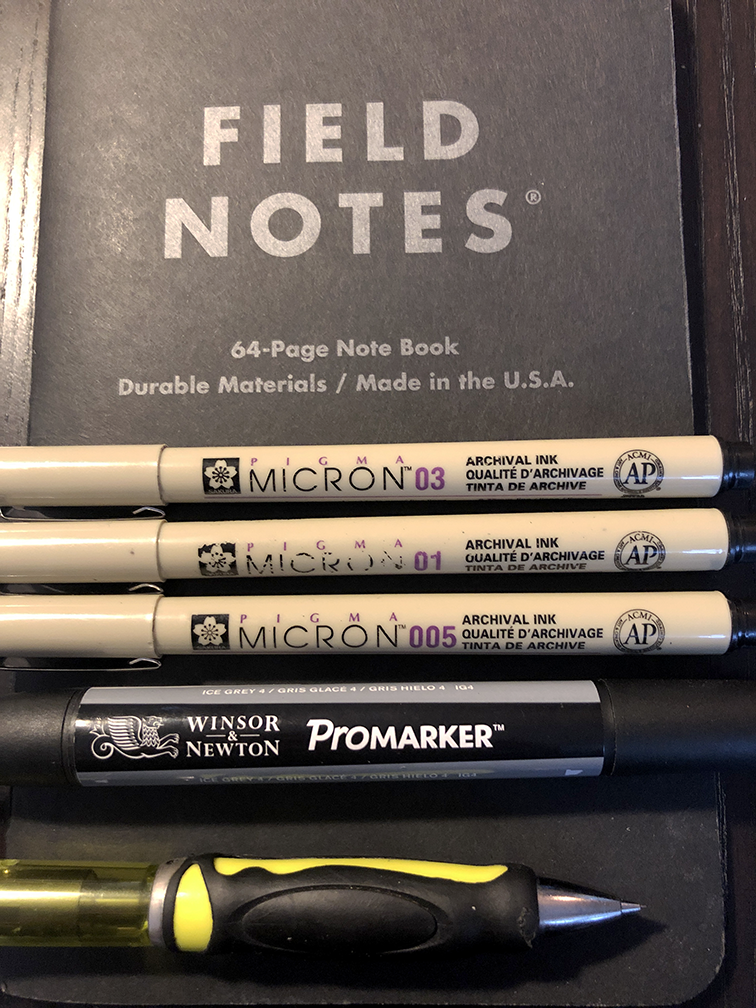
Step one: rough outline
Start by drawing the rough outlines of your village with a mechanical pencil. In this case, I’m just drawing a small cluster of houses, but if you’re going for a larger village or town, you might want to put some though into if there should be any main roads, village squares or winding alleys you want to include.
Consider some variation of sizes and shapes, to make it look organic and not too monotonous. A settlement grows over time, and not all buildings will be built the same way and for the same purposes. I also like to throw in some small details, like crates and barrels, foliage or trees.

Step two: ink outline
I use a 0.1 Micron marker to re-draw the outlines. I then erase the lines drawn with the mechanical pen. This will damage the inked outlines slightly, but that’s not a problem as we will go over them again in the next step.
Always when drawing maps, you need to think about the balance between making the map easy to understand, and making it realistic or pretty. The doors on my map are obviously exaggerated, but I want to make it clear to whoever is looking at the map where the doors are, since that’s critical information (and to be honest, I think it looks fine).
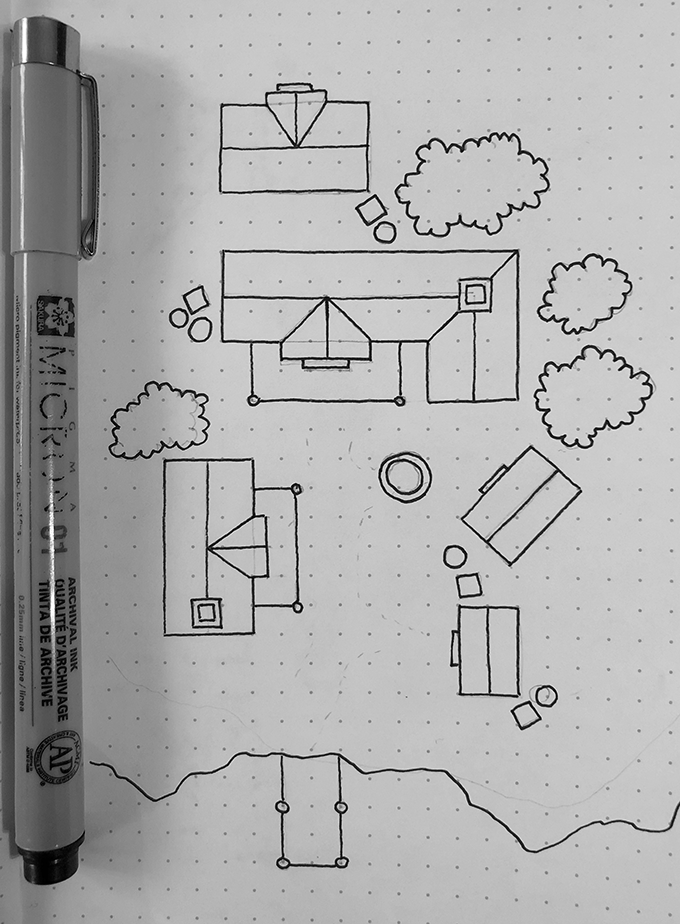
Step three: add weight
For this tutorial, I used a 0.3 Micron marker to add weight to some of the outlines. This provide a good, clear contrast when we start adding finer details in the next few steps.
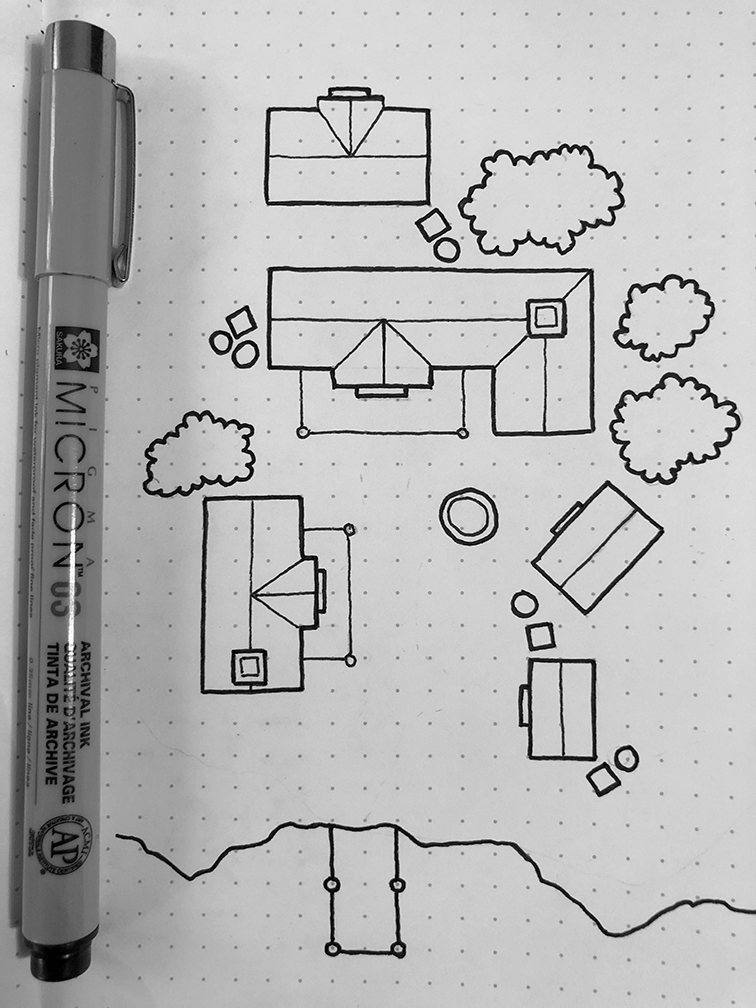
Step four: add roof details
I use a 0.1 marker to add some texture to the thatched roofs. Start by placing the tip of the pen on the ridge, and then draw a quick line towards the edge of the roof. As you move the pen towards the edge of the roof, apply less pressure to make the line thinner at the end. This might need a little bit of practise, so do that on a separate paper. Alternatively, you can skip this technique and just draw normal lines of varying length — that will also look good.
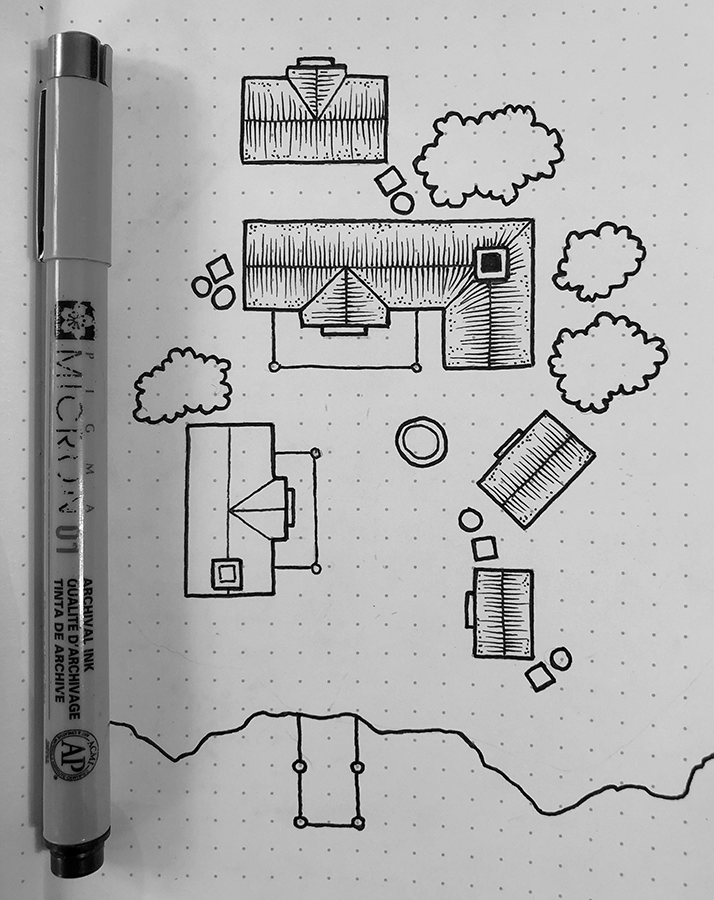
Step five: more details
With a 0.05 marker, add finer details, such as roof tiles, wood texture to porches, crates and barrels. Also, since this is a lakeside settlement, I add some wavy lines to the coastline.
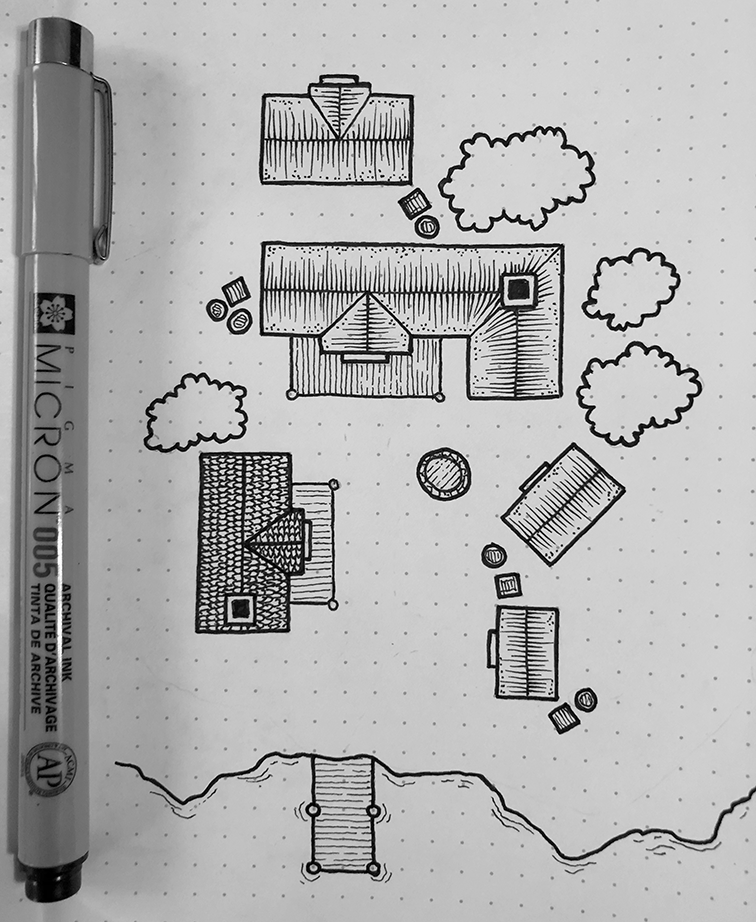
Step six: texture and rubble
Before moving on to shadows, I add some texture to the ground by drawing stones and dots. Since I want the settlement to look organic, I try to make sure there are as little white space as possible. In hindsight, I could probably have added more texture to this map, but it’ll have to do for now — it’s super easy to go back and work a bit more on it.
I add some leaves to the trees/foliage to give them volume and texture.
For this step I use a 0.1 marker (and a 0.05 marker for the leaves).

Step seven: shadows
In this step I use my grey Promarker to add shadows to the map. I’ve decided that the light should come from the top left corner, meaning that roof angles sloping towards the lower and right parts of the map should have shadows (as well as on the ground to the south and east of objects with height (such as buildings, crates and trees).
I also add a shadow to the coastline, to make it pop out more.
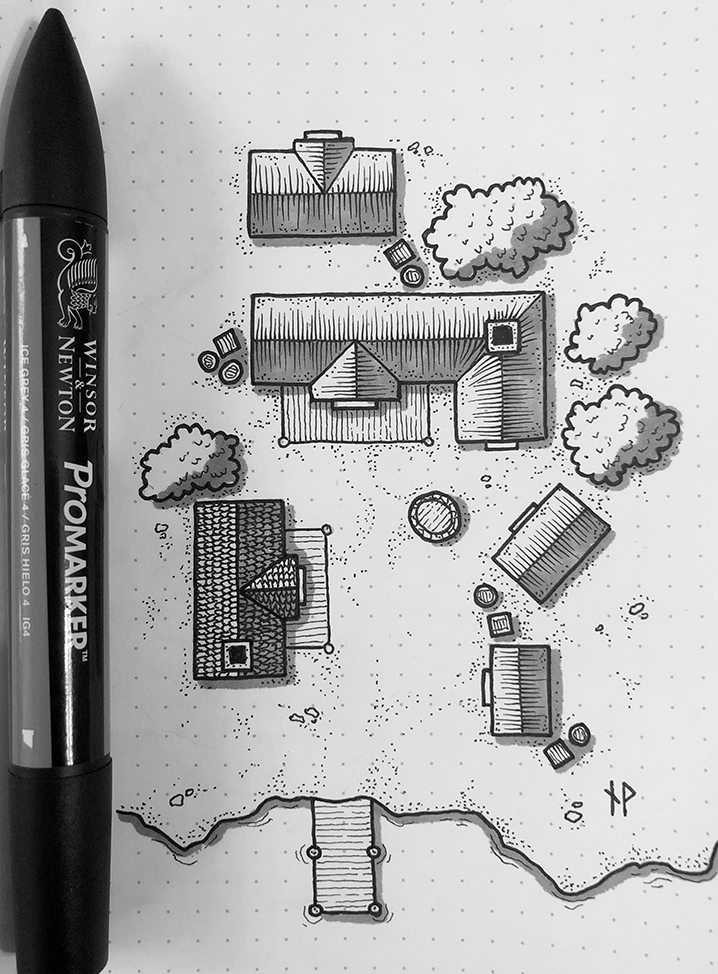
Step eight: clean up
I use Photoshop to work with the levels, and getting the colors right, also removing some of the dots.
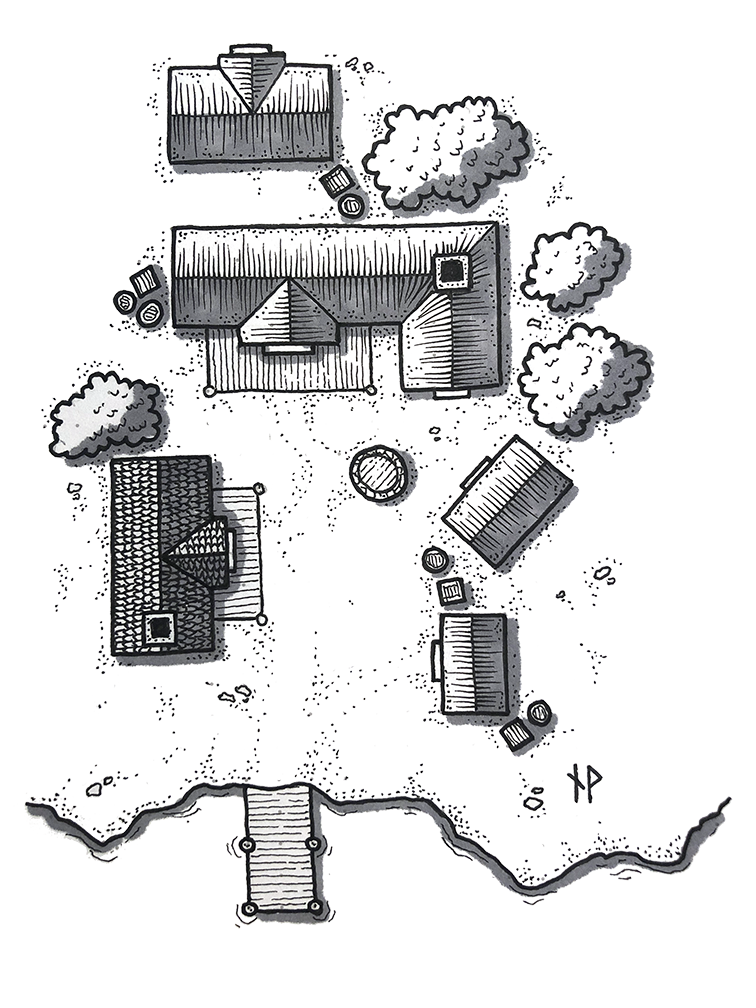
And that’s it! You have just drawn a map over a small settlement in your campaign world! I hope you enjoyed this tutorial, and found it helpful
If you like my maps, please feel free to follow me on Instagram, where I post more of my work: https://www.instagram.com/paths.peculiar/
More tutorials:
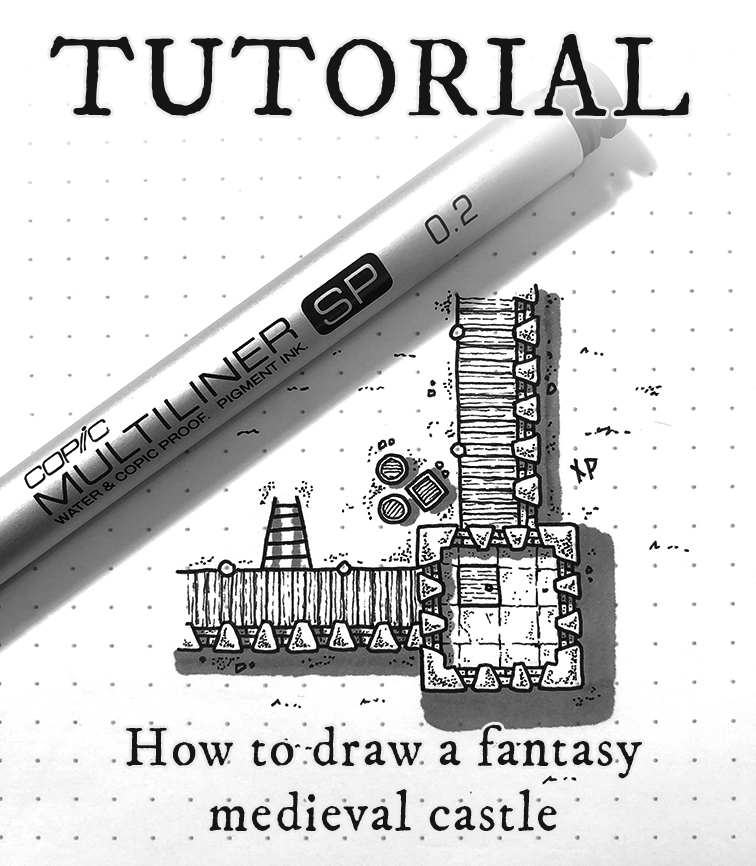



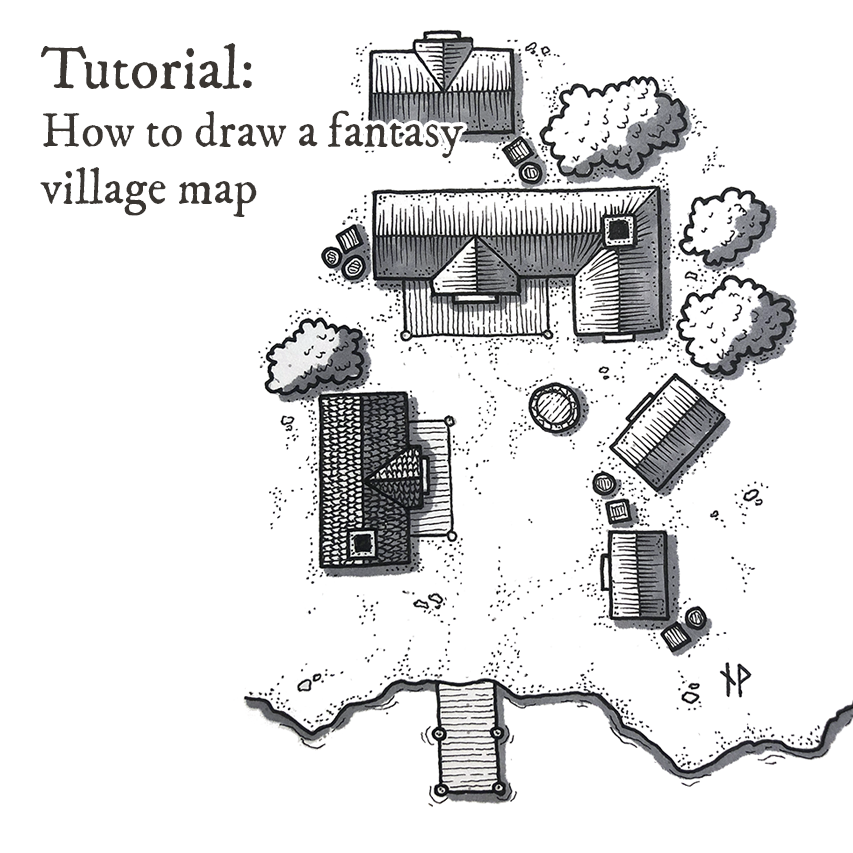
I love your work and I really appreciate the tutorials! You inspired me to start doodling at work during calls, and eventually I picked up my own set of Sakura pens and a marker. Thanks for taking the time to share your gift!
I’m really glad you liked it, and super-happy that I was able to inspire someone! Thank you for your kind words, and good luck with the drawing!
What is the scale of each square?
I’d say about five feet or so. That’s standard in most fantasy roleplaying games.
Väldigt bra tutorial!
Hur skulle du göra om taket på byggnaderna är enfärgade, typ svarta. Det blir lite för markant om man fyller hela taket med färg?
Thanks for taking the time to do this. Can’t wait to try your technique!
Just started drawing maps and following your tutorials. Map came out great but the paper soaked up the ice grey promarker and so I ended up with greyed out walls and furniture. How do you get your shadows so straight without going over your lines??? I used a ruler but ink gets under the ruler…
It sounds like you have the wrong type of paper. Have you tried a paper with a less “porous” surface? I tend to use Rhodia DotPad, that handles ink very well with little to no bleed. I don’t use rulers, but rather freehand the shadows (recently I even started adding the shadows in Photoshop as part of the post production).
Just had a play at following through this. Really nice tutorial and nice to actually see it broken down so concisely. I even dug out my pens!
Thank you for these wonderful tutorials, I’ve been doodling like crazy. I’d like to show you what I’ve done with your guidance.
Glad to hear that, show me!
How can I show you??
I’m so honored you replied, and I am so happy to have stumbled upon your website and amazing artwork!
https://photos.app.goo.gl/W5oAZYQuqmr2uWde8
?
Here’s a drawing I’ve done using your tutorial as a guide. It’s not that good, but I had a lot of fun doing it, and will end up using this as part of my one page tabletop rpg while I sit around with a few beers with my in-laws?️?️??️? Thank you for your inspiration! You’re an amazing artist!
What do you mean it’s not that good? I think it looks great! Well done!
Thank you so much!
@gregory: I agree with Niklas, your “just-over-the-sewers-level”-map looks amazing !
@Niklas: thanks for the tutorials… I’ll have to try your method for the dungeon I started to draw (where the Domesday book can be found!). Who knows, i might get it done within 1D20+6 months
I absolutely love your style. The tutorials are great too, really helping me with my own maps. Thanks for all of the content.
Thank you very much, Dave!
How would you advise scaling up this type of map to a city level? I’m using A4 paper to draw a small village of around 15-20 houses, but I think the style would look great on a city. Any advice for something around 100+ houses?
I haven’t tried making a large city yet. Would probably draw the houses with a *lot* less details in order to pull that off.
I was wondering if you had any tips for drawing tents or canvas awnings? I want to do something with market stalls or have some houses with a Mediterranean feel to them, so I wanted to put some canvas awnings on one side of them. I’m struggling to give them the right feel though. Any suggestions?
Hm, don’t think I’ve done any top-down maps with tents, but perhaps you could draw some inspiration from this isometric one? https://www.wistedt.net/2020/03/28/the-far-oasis-inn-desert-fantasy-isometric-map/
Ah, thanks.
I’ll try a few different ideas, thanks for the link.
Hey, thanks for the tutorial!
Are you aware of that game? Since like they use the same technique: https://mightofmerchants.com/
I was not aware of it, and I agree the art style seems very similar. Perhaps they’ve used my tutorials? 🙂
Great tutorial! Do you have any scanning tips to remove the Rhoda dots quickly?
Quickly? No. But there is a tutorial on how to clean up ink drawings here on the website: https://www.wistedt.net/tutorials/tutorial-how-to-clean-up-an-ink-drawing-in-photoshop/
Is there any chance you could do certain builds within a village like a windmill, vineyard or blacksmith.
If you have or have seen one may you point me in the right direction.
I love your drawings they are incredibly detailed and clear/clean. Keep up the good work
Thank you very much for sharing!!! Great work my friend!